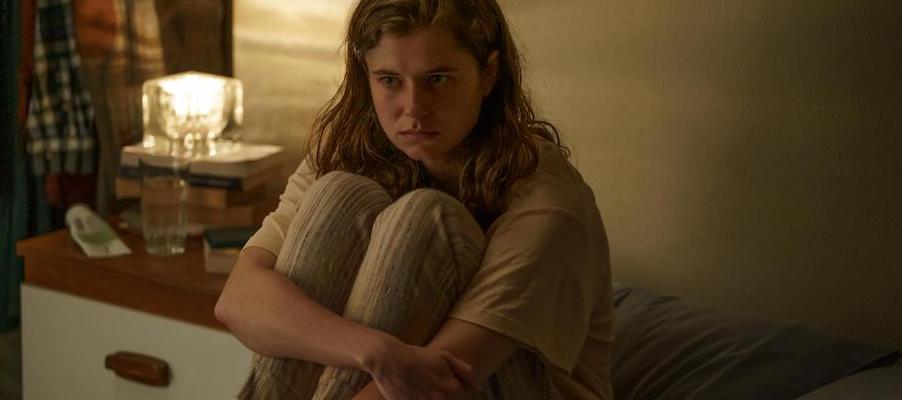
Like most everyone, I truly enjoy a nice streaming platform binge during breaks between my Ph.D. classes and teaching. And, of course, during an endometriosis flare when I’m relegated to the couch with my heating pad. This past week, I found the television adaptation of Sally Rooney’s novel, Conversations with Friends, on Hulu and began my binge. The plot centers around Frances (Alison Oliver), a young writer and student at Trinity College in Dublin who surreptitiously navigates an affair with struggling actor Nick Conway (Joe Alwyn) after meeting him via his wife, Melissa (Jemima Kirk) at a poetry reading. After Bobbi (Sasha Lane), Frances’ best friend, charms Melissa with drinks and conversation, Melissa invites them both to her home for dinner. Amongst a burgeoning friendship between the four, an affair erupts between Frances and Nick. Alongside her personal tumult, Frances is also plagued with painful periods characterized by symptoms I recognized immediately. I hit pause on my Apple TV remote, looked at my ever-faithful, four-legged, binge-companion, Starla Belle, and said, “Frances has endo.” Starla wagged her tail in agreement, and we continued to watch.
This part of the series’ storyline intrigued me most because of how little endometriosis is represented in the media. Despite the occasional “Speak Endo” Orlissa commercial, or a small segment in a one-off episode of a mediocre medical drama, one never really sees endometriosis on television. To be clear, seeing endometriosis represented in a mainstream drama is exciting and important. We, as endometriosis patients, need to see our lives on screen. It even prompted me to look up articles written about Frances’ endometriosis story line and how the director “got it right,” but I found myself asking, “but did they?” It was a conflicting experience for me as a patient because, on one hand, I should be happy to see endometriosis being discussed on such a large platform. On the other, the advocate in me disagreed with the way the series handled the proper medicine and treatment of the disease.
What the producers and director did well was illustrate the day-to-day struggle, as well as give a bit of visibility to an invisible illness. In one scene, Frances faints in the street from excruciating pain, which is common. Another is the graphic scene where the camera focuses on Frances’ underwear, giving attention to the extremely heavy periods that endometriosis can experience. While at home visiting her mother, Frances is hit with a wave of pain which causes her to stumble into the bathroom, where she removes her underwear completely. When she looks over into her underwear, she finds a pool of blood which terrifies her. It takes this moment of severity for her to reach out and ask for help. After yelling, “MOM,” her mother rushes in, sees the blood, and takes her to the emergency room. But at this point in the narrative, following one of the steamy, not-so-protected sexual encounters between Frances and Nick, we seem to be led to believe the bleeding is from a miscarriage.
While in the emergency room, Frances experiences another common experience familiar to women with severe pelvic pain: the examination. She has to give a detailed account of her sex life to the doctor, who lacks warmth and seems to be in a rush. I would bet that anyone who has experience living with endometriosis or any chronic disease cringed when they watched this scene because the series nailed the experience: chilly, assembly line-like conversation based around the most intimate details of a person’s life; the doctor then hurries off and the patient is left frightened and traumatized. When Frances’ doctor determines that she did not have a miscarriage, he refers her to “get a scan” with an OBGYN.
This is where the Conversation with Friends’ depiction of endometriosis becomes problematic. I will admit that there are a few things done well in this scene. First, the austere delivery of Frances’ diagnosis is something I have experienced myself along with many other women I know. The audience gets to see how helpless we feel when receiving news that our pain has no cure and our fertility is compromised; however, when the doctor remarked that “surgery is only necessary for severe cases,” and should “focus on pain management so it doesn’t become debilitating,” I had to hit pause on my AppleTV remote again and take a walk.
Firstly, endometriosis can only be diagnosed via pathology following a laproscopic excision surgery. Without a surgical diagnosis, claiming one has endometriosis is simply a guessing game. According to Dr. Karli Goldstein, an endometriosis excision specialist and endometriosis patient, “without [surgical diagnosis], patients may not have endometriosis or a real diagnosis for years.” Also, Dr. Goldstein explains that quality excision surgery is beneficial for all patients and all stages of the disease because it essentially treats endometriosis by removing it, not just for “severe cases.” In addition, pain management is not always the lasting remedy. “The first line,” Dr. Goldstein explains, “is anti-inflammatory pain management timed around the period or before the bleed starts. Birth control pills can be used to stop menstruation itself and lessen the pain surrounding it. Many patients, even those who are young with early stages, may find at some point their pain breaks through the pill’s ability to help.”
The staging of endometriosis is not necessarily representative of the severity of one’s symptoms; therefore, determining the severity of pain, when it is relative to the patient, is difficult. Conversations with Friends successfully addresses endometriosis and represents the symptoms through its protagonist effectively, and accurately; however, the show misses an opportunity to educate with respect to accurate information about the disease and its proper treatment. Frances’ appointment with her doctor provided the same incorrect information that many endometriosis patients receive, leaving Frances feeling hopeless, the patients watching feeling hopeless, and those of us who advocate for endometriosis patients reeling.
One could argue that television, as well as film and other art forms, is not bound to moral improvement and education. One could also argue that this episode illustrates real life accurately in the way this doctor is providing the patient with inaccurate information. In real life, endometriosis patients are under-diagnosed and under-treated. One in ten women have endometriosis, and the majority are given their diagnosis and treatment options in the same manner. The audience sympathizes with Frances as she feels scared and confused. They sit with her as she peruses the Endometriosis Association of Ireland’s website for the information she didn’t get in her consultation. However, when representing a disease that is so misunderstood by both medical professionals and the public, it is imperative that artists are accurate in the information they provide their audience. There are likely some who watched and gleaned her consultation scene as truth which can be dangerous. The moment to change lives was there for the taking but fell short. Various articles claimed that Conversation with Friends “got it right,” and in some ways the show did. But until excision surgery is always mentioned in any context as the gold standard of treatment for endometriosis, it’ll be almost right.









